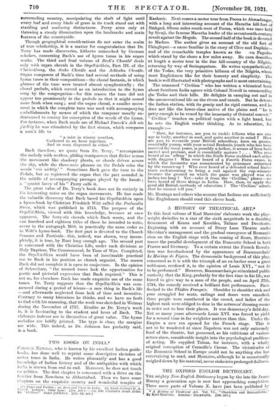A HISTORY OF THEATRICAL ART.*
IN this final volume of Karl Mantzius' elaborate work the play- wright dwindles to a star of the sixth magnitude in a dazzling firmament of Keans and Kembles, Talmas and Devrients. Beginning with an account of Drury Lane Theatre under Sheridan's management and the gradual emergence of Romanti- cism on the English stage with the coming of Kean, Mantzius traces the parallel development of the Romantic School in both France and Germany. To a certain extent the French Revolu- tion was foreshadowed by the appearance of Beaumarchais' Le Mariage de Figaro. The democratic background of this play, concerned as it is with the triumph of an ex-barber over a great nobleman, rendered it, in the opinion of Louis XVI., " not fit to be performed." However, Beaumarchais,po stimulated public curiosity that the King, probably for the first time in his life, was forced to give way to a man of the people, and on April 27th, 1784, the comedy received a brilliant first performance. Paris flocked to the Theatre Francais. Shoulder to shoulder rich and poor struggled for seats, railings and doors were smashed, three people were smothered in the crowd, and ladies of the highest rank were obliged to dine in the actresses' dressing-rooms in order not to lose their places. It was democracy's field-day. Not so many years afterwards Louis XVI. was forced to yield for a second time in far weightier matters than this. Under the Empire a new era opened for the French stage. This is not to be wondered at since Napoleon was not only extremely- fond of the theatre, but possessed, as his criticisms of various actors show, considerable insight into the psychological problems of acting. He supplied Telma, for instance, with a wholly original conception of Corneille's Caesar. The vicissitudes of the Romantic School in Europe could not be anything else but entertaining to read, and Mantzius, although he is occasionally weighed down by his material, never sinks into prolonged dullness.










































 Previous page
Previous page